Have you ever wondered if your feline friend experiences emotions like you do? Cats are often seen as mysterious creatures, but their capacity for feelings goes beyond mere instinct. Observing their behaviors and interactions can offer fascinating insights into the rich tapestry of emotions that cats are capable of experiencing. From subtle body language cues to more obvious displays, the emotional world of cats is a captivating subject that may surprise you.
Key Takeaways
- Cats can feel emotions as they exhibit complex behaviors and reactions.
- Emotional cues like body language, vocalizations, and expressions indicate a range of feelings.
- Research shows that cats have brain structures supporting emotional responses.
- Cats display empathy, bonding, and emotional connections with humans and other animals.
- Managing fear, anxiety, and triggers can help in maintaining a cat's emotional well-being.
Emotional Expressions of Cats
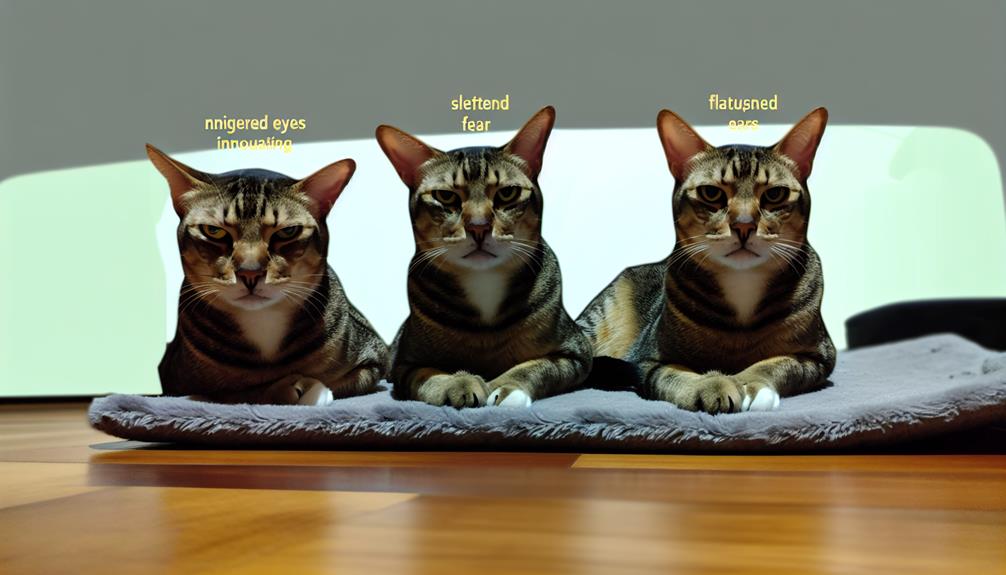
When observing cats, you can discern their emotional states through subtle cues in their body language and vocalizations. Cats use a combination of vocalization cues, body language, facial expressions, and tail movements to communicate their feelings. For instance, a cat with flattened ears, dilated pupils, and a twitching tail may be displaying signs of fear or aggression. On the other hand, a cat with relaxed ears, slow blinking eyes, and a softly swaying tail is likely feeling content and at ease.
Vocalization cues also play a crucial role in understanding a cat's emotions. A cat's meow can vary in pitch, tone, and intensity, giving insight into whether they're feeling hungry, anxious, or playful. Purring is often associated with happiness and comfort, while hissing or growling may indicate fear or anger.
Understanding Cat Body Language
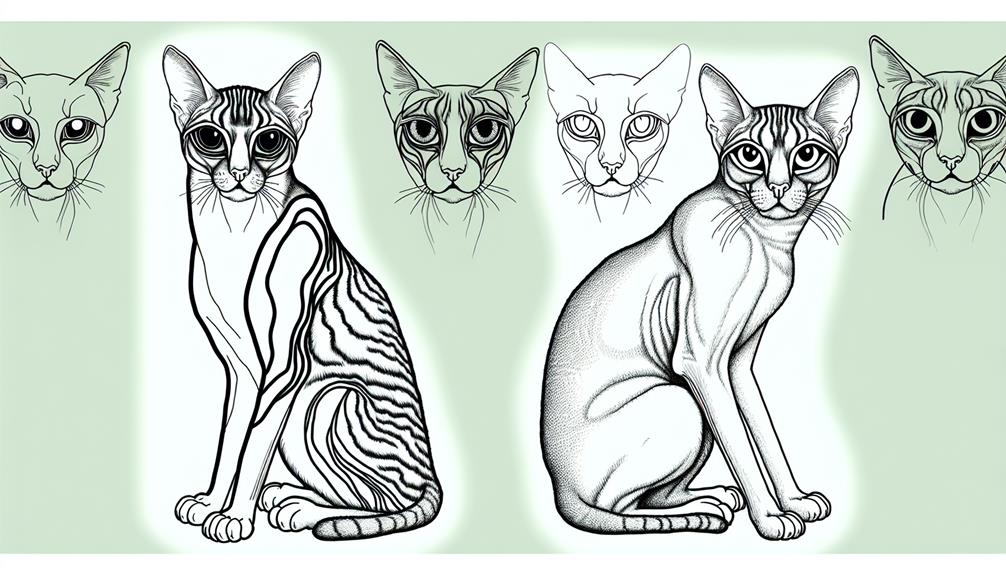
To better understand cats, pay close attention to their body language cues, which are key indicators of their emotions and intentions. Understanding cat communication and decoding feline body language can provide valuable insights into your feline friend's feelings.
Cats use a combination of vocalizations, postures, and gestures to express themselves. For example, a cat with a relaxed body posture, softly blinking eyes, and an upright tail is likely feeling content and friendly. On the other hand, a cat with flattened ears, dilated pupils, and a puffed-up tail may be feeling fearful or threatened.
When a cat swishes its tail rapidly or arches its back, it could be a sign of agitation or aggression. By observing and interpreting these subtle cues, you can better respond to your cat's needs and emotions, strengthening the bond between you and your feline companion. Paying attention to their body language is a crucial step in fostering a harmonious relationship with your cat.
Signs of Happiness in Cats
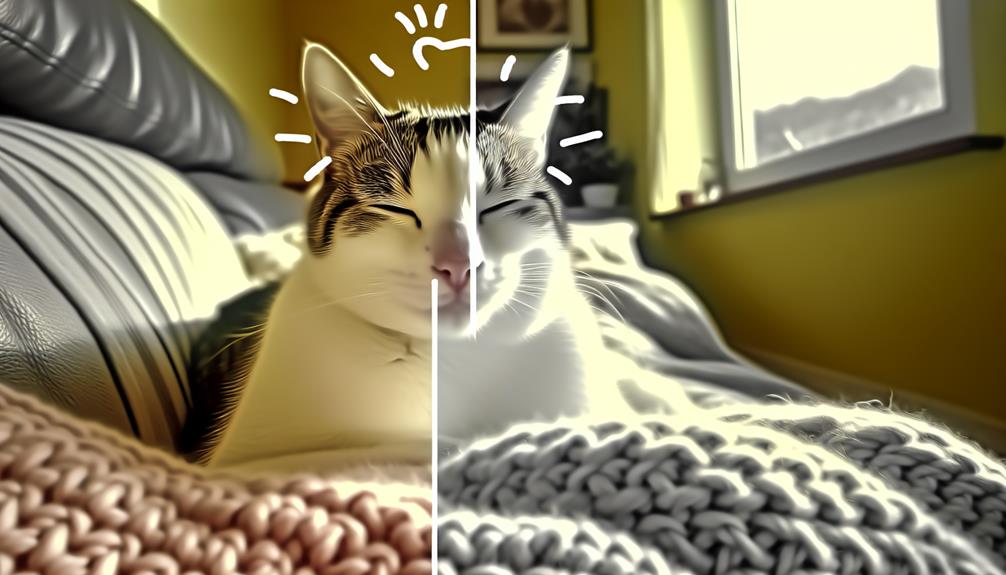
You can easily tell when a cat is happy by observing its body language cues. Signs of happiness in cats include content purring and playful behavior. When a cat is happy, it may approach you with a relaxed body language, showing trust and comfort. The way a cat holds its tail can also indicate happiness; a slight upward curve or a relaxed swish signals contentment.
Additionally, happy cats often exhibit affectionate gestures such as head bunting, where they gently bump their head against you as a sign of love and trust. They may also knead with their paws, a behavior that stems from kittenhood when they kneaded their mother's belly for milk. Playfulness is another clear sign of a happy cat, as they engage in activities like chasing toys, running around, and engaging in gentle wrestling matches with their feline or human companions. Keep an eye out for these behaviors to ensure your feline friend is content and joyful.
Can Cats Experience Love?
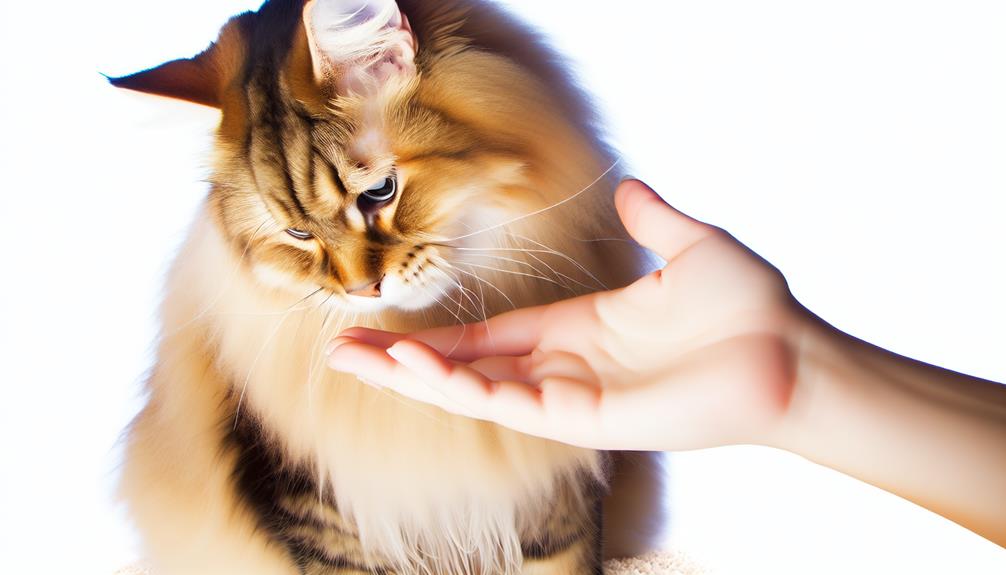
Cats exhibit a range of behaviors that suggest they do form strong emotional bonds with their human caregivers. From rubbing against their owners to purring contently in their presence, cats display signs of affection and attachment. These behaviors indicate a level of trust and comfort that goes beyond mere companionship, suggesting a deeper emotional connection. By observing how cats interact with their humans and other animals in their environment, we can gain insights into the complexity of their relationships and the depth of their emotional experiences.
Understanding the nuances of feline bonding behavior can shed light on the true nature of the connections that cats form with their human companions. By recognizing the signs of affection and attachment that cats display, we can appreciate the depth of their emotional experiences and the unique ways in which they express their love. Through careful observation and study, we can uncover the mysteries of feline relationships and gain a greater understanding of the profound emotional connections that cats are capable of forming.
In exploring the ways in which cats show affection and form bonds with humans, we can gain a deeper appreciation for the complexity of their emotional lives. By observing their behaviors and interactions, we can learn to recognize the subtle signals of love and attachment that cats exhibit. Through this understanding, we can develop a greater sense of empathy and connection with these enigmatic creatures, enriching our relationships with them and deepening our appreciation for the unique bond that we share.
Feline Bonding Behavior
Cats can indeed experience love, forming deep bonds with their human companions through affectionate behaviors. Feline bonding dynamics involve a range of social interactions that contribute to the emotional connection between cats and humans.
Here are some key aspects of feline bonding behavior:
- Mutual grooming: Cats show affection by grooming their human companions, reinforcing the bond between them.
- Purring: The soothing sound of a cat's purr not only indicates contentment but also signifies their attachment to you.
- Kneading: When cats knead on your lap or a soft surface, it's a sign of comfort and trust, strengthening the bond between you and your feline friend.
Cat Attachment to Humans
Understanding the depth of attachment cats can form with their human companions sheds light on the question of whether felines can experience love. Cat loyalty is evident in the emotional bonding they develop with their owners, showcasing a strong human connection. Cats often display affection through actions like kneading, head-butting, and purring, indicating their desire for companionship.
This emotional bond is a two-way street, as humans also benefit from the companionship dynamics shared with their feline friends. The mutual trust and comfort that develop over time illustrate the significance of these attachments. While the nature of cat love may differ from that of humans, the depth of the bond and the loyalty displayed by cats towards their owners suggest a form of love unique to the feline species.
Do Cats Feel Sadness?
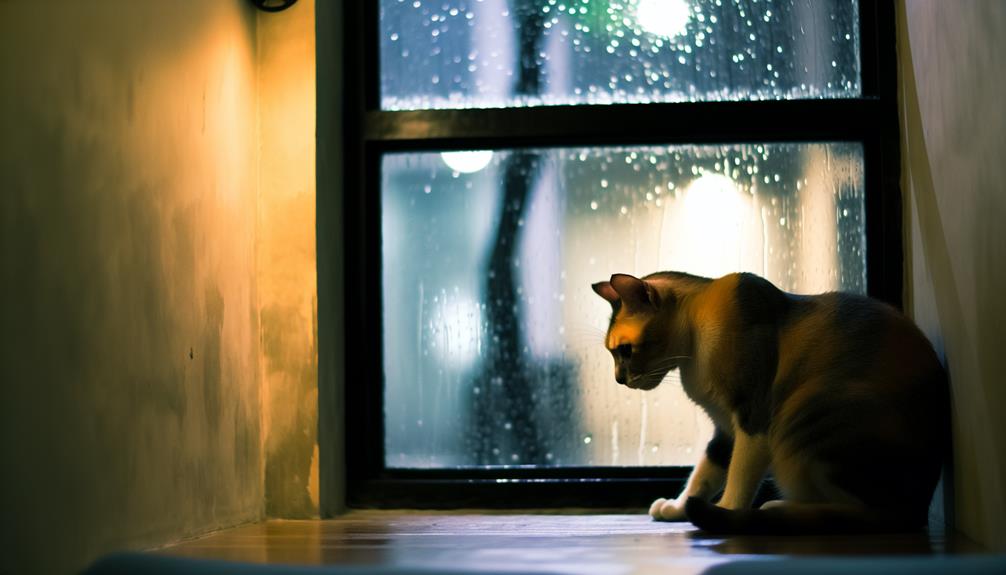
Feeling sadness is a complex emotion that many feline companions experience in response to various stimuli. Cats can indeed feel sadness, and their ability to experience this emotion is a testament to their emotional depth and complexity.
- Cat Empathy: Cats are capable of empathy, allowing them to pick up on the emotions of their human companions and other animals. This empathetic nature enables them to mirror the feelings of sadness they perceive in others.
- Feline Emotional Intelligence: Cats possess a high level of emotional intelligence, which means they can recognize and respond to different emotions, including sadness. They may show signs of sadness through changes in behavior, such as decreased appetite, excessive sleeping, or withdrawal.
- Bonding and Loss: Cats form strong bonds with their humans and animal companions. When they experience loss or separation from a loved one, cats can exhibit signs of sadness, such as vocalizing more, seeking comfort, or becoming more aloof.
Fear and Anxiety in Cats
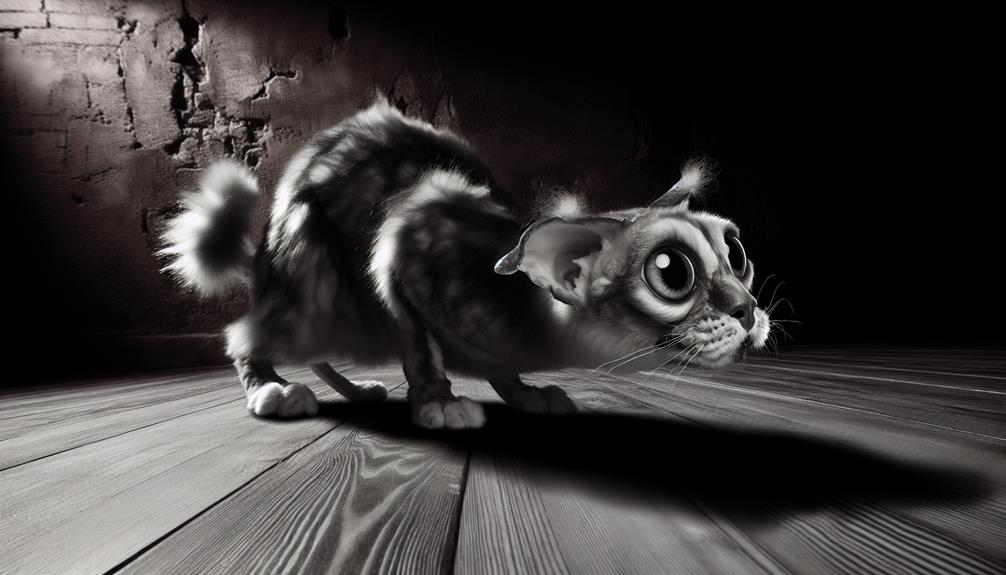
When faced with certain triggers or stressful situations, it's important to recognize the signs of fear and anxiety in your feline companion. Cats exhibit behavioral cues when experiencing fear or anxiety, such as hiding, excessive grooming, or changes in appetite. Common stressors for cats include loud noises, unfamiliar environments, or changes in routine.
To help your cat cope with these emotions, provide safe spaces like cozy hiding spots or calming pheromone diffusers. Engaging your cat in interactive play or using puzzle feeders can also serve as coping mechanisms for anxiety. Understanding your cat's triggers and creating a soothing environment can greatly reduce their fear and anxiety levels.
Additionally, maintaining a consistent daily routine and ensuring regular veterinary check-ups can help prevent overwhelming feelings of stress. By being attentive to your cat's behavior and implementing appropriate coping strategies, you can support them in managing their fear and anxiety effectively.
The Science Behind Cat Emotions
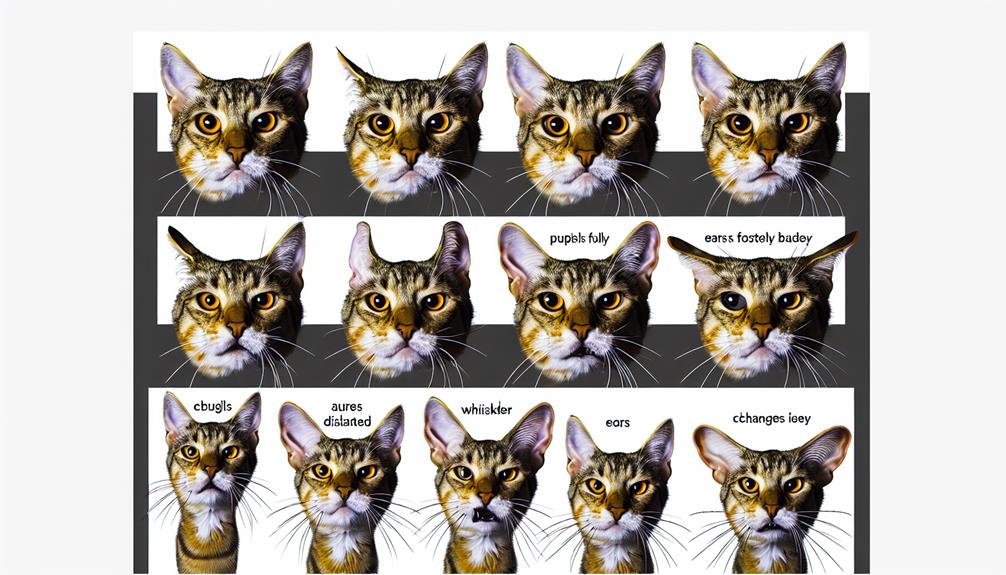
Delving into the realm of feline psychology sheds light on the intricate workings behind cat emotions. Cats' emotions aren't just random reactions but are rooted in a combination of neurological processes and observable behavioral patterns.
- Neurological basis
- Cats, like many mammals, have complex brain structures that regulate emotions. The limbic system, which includes the amygdala and hippocampus, plays a crucial role in processing emotions in cats.
- Behavioral patterns
- Cats exhibit a wide range of behaviors that reflect their emotional state. From purring when content to hissing when threatened, these behaviors are outward expressions of what's happening internally.
- Understanding the connection
- By studying the neurological basis of cat emotions alongside their behavioral patterns, researchers can gain a deeper understanding of how cats experience and express emotions. This knowledge can help pet owners provide better care and support for their feline companions.
Empathy in Felines
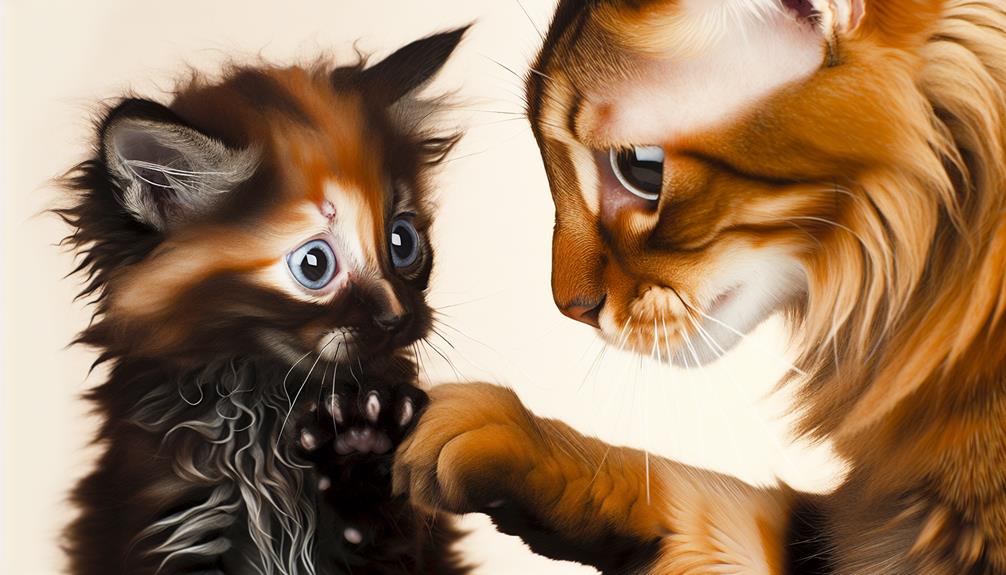
You may be surprised to learn that cats are capable of empathy.
They can exhibit emotional mirroring behavior, reflecting the feelings of those around them.
Through acts of empathy, cats can strengthen the bond they share with their human companions.
Cats and Empathy
In exploring the realm of feline emotions, one can't overlook the intriguing topic of cats and empathy. Cats exhibit empathy in fascinating ways, showcasing their emotional intelligence:
- Empathy Development: Cats are capable of developing empathy towards their human companions and even other animals, showing understanding and support in times of need.
- Emotional Intelligence: Felines have a remarkable ability to perceive and respond to the emotions of those around them, displaying a level of emotional intelligence that surprises many.
Understanding how cats demonstrate empathy sheds light on their complex emotional lives, highlighting the depth of their connections with both humans and other animals.
Emotional Mirroring Behavior
When observing cats' emotional mirroring behavior, you can witness their innate ability to empathize with those around them. Mirror neurons play a crucial role in this behavior, allowing cats to mimic the emotions of others. This emotional contagion showcases their capacity for empathy, enabling them to understand and share the feelings of their human companions or fellow felines.
Through this mirroring behavior, cats can create a deeper connection with those they interact with, fostering a sense of understanding and support. Whether it's sensing your happiness and responding with purrs or picking up on your sadness and offering comforting snuggles, cats demonstrate a remarkable ability to mirror emotions and show empathy towards others.
Bonding Through Empathy
Bonding through empathy is a fundamental aspect of feline behavior, showcasing their ability to connect emotionally with others. Cats develop empathy through various stages, allowing them to form deep emotional connections with their human companions and even other animals.
This emotional bond is evident in their behavior, such as comforting their humans when they're sad or anxious, showing concern when someone is sick, and even mirroring the emotions of those around them. Through empathy development, cats can't only understand but also share the feelings of those they're bonded to, creating a unique and profound connection that goes beyond simple companionship.
- Empathy development
- Emotional connections
- Understanding and sharing feelings
Jealousy and Envy in Cats
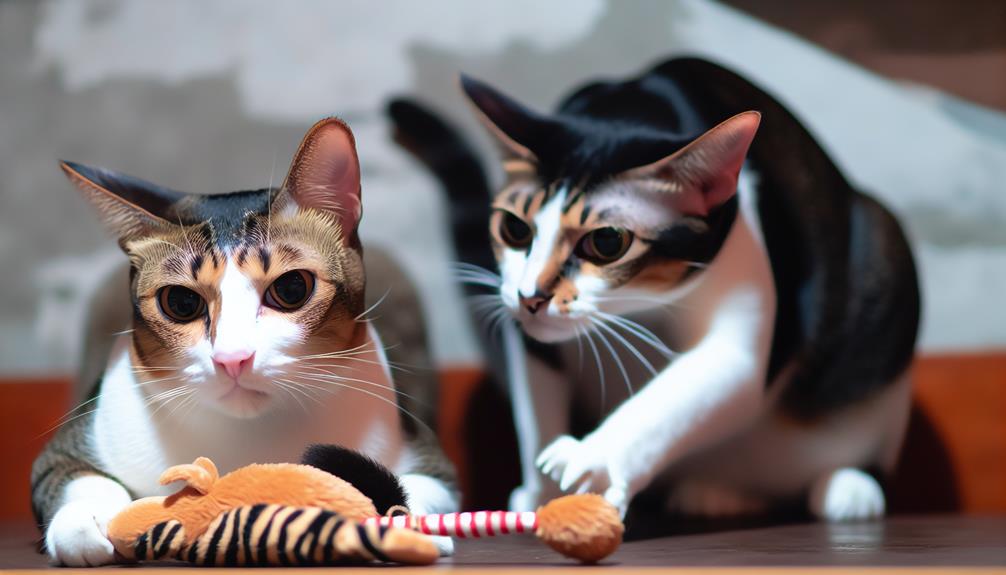
Jealousy and envy can be observed in cats through their body language and behavior towards other animals in the household. Envy triggers may include a cat trying to monopolize the attention of their human or becoming possessive over their toys or food. This envy can lead to jealous behavior such as hissing, swatting, or even trying to block another animal from interacting with their favorite person.
When a new pet is introduced into the home, a cat may exhibit signs of jealousy by sulking, avoiding the new animal, or displaying aggressive behavior towards them. Cats are known for their territorial nature, and any threat to their territory can trigger feelings of envy and jealousy. It's essential to provide reassurance and attention to all pets in the household to help mitigate these emotions and prevent conflicts.
Understanding the signs of jealousy and envy in cats can help pet owners navigate multi-pet households and ensure a harmonious environment for all furry companions.
Anger and Aggression in Cats
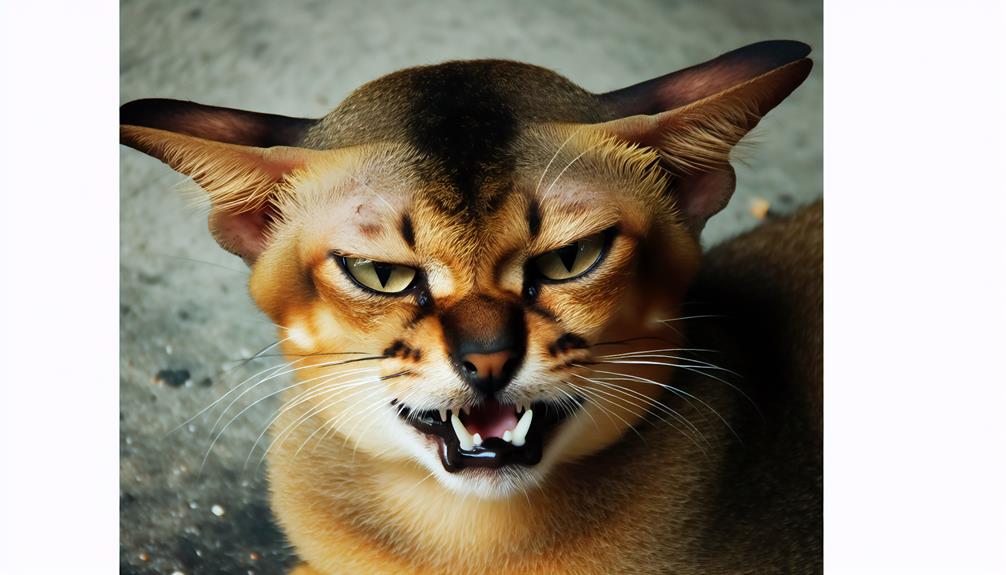
You may notice that your cat's behavior can sometimes display signs of anger and aggression. Understanding what triggers these emotions in your cat is crucial in managing their behavior effectively.
Look out for specific signs of aggression to address any issues promptly.
Cat's Aggressive Triggers
Understanding a cat's aggressive triggers can help you address and manage your pet's anger and aggression effectively. Some common triggers include loud noises, sudden movements, and feeling cornered.
To help calm your cat and prevent aggressive behavior, try using calming techniques such as providing hiding spots, creating a peaceful environment, and using pheromone diffusers.
When you notice signs of aggression, it's essential to employ deescalation methods like giving your cat space, avoiding direct eye contact, and speaking softly.
Managing Cat's Anger
To effectively manage a cat's anger and aggression, it's essential to identify and address the underlying triggers that contribute to their behavior. Dealing with frustration in cats is crucial to prevent aggressive outbursts. Cats can become agitated due to various factors such as changes in their environment, lack of mental stimulation, or feeling threatened.
Managing cat aggression involves creating a safe and secure space for your feline friend, providing outlets for their energy through play and toys, and ensuring they've a consistent routine. It's important to observe your cat's body language for signs of distress or anger, and to respond calmly to avoid escalating the situation.
Signs of Cat's Aggression
What're the common signs of aggression and anger displayed by cats? Cats can exhibit various signs when feeling aggressive or angry. Understanding these signals can help manage their behavior effectively. Here are some key indications to look out for:
- Hissing and Growling: Cats often hiss or growl when they're feeling threatened or upset.
- Ears Pinned Back: When a cat's ears are flattened against their head, it can signify aggression.
- Dilated Pupils: Enlarged pupils can indicate heightened arousal, potentially leading to aggressive behavior.
Aggression management involves recognizing these signs early on and understanding triggers that may cause your cat to become aggressive. By being aware of these cues, you can help create a calmer and safer environment for your feline companion.
Bonding and Attachment With Humans

Establishing a strong bond with humans, cats often demonstrate their affection through various behaviors and cues. Attachment dynamics between human and animal play a crucial role in the emotional connections shared by feline friends. Cats form attachments with their humans through activities like kneading, head-butting, purring, and even following them around the house. These actions are ways in which cats express their bond and attachment to their human companions.
When you spend quality time with your cat, such as playing, grooming, or simply sitting together, it strengthens the bond between you. Cats are known to seek out their human's company, showing a preference for familiar scents and voices. They may also exhibit behaviors like rubbing against your legs or sleeping close to you to deepen their attachment. Responding positively to these gestures can further solidify the bond you share with your feline friend. By understanding and reciprocating these displays of affection, you can nurture a strong and lasting connection with your beloved cat.
Cats' Response to Grief
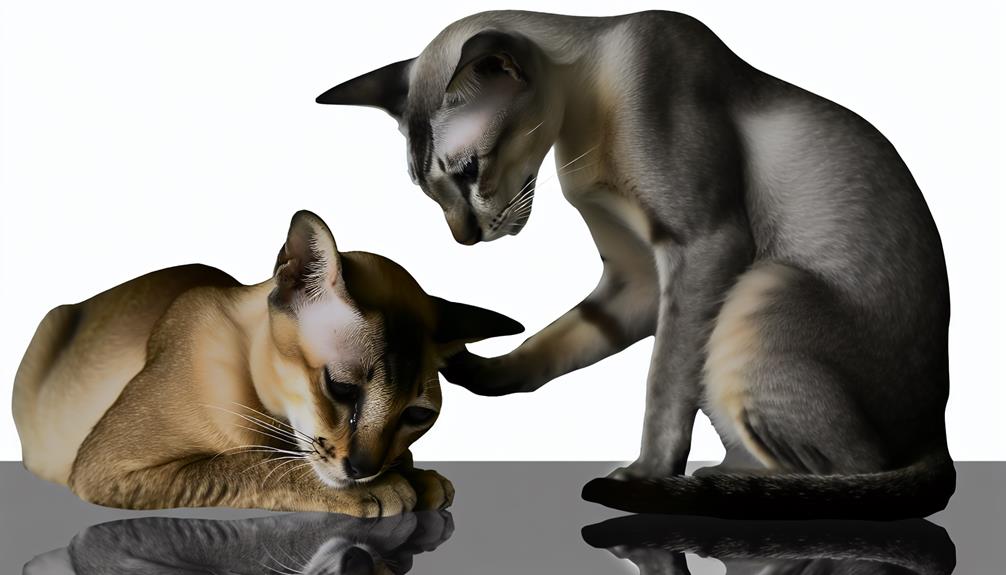
When cats experience loss, they may exhibit signs of mourning, such as changes in behavior or appetite.
It's important to recognize these signs and provide comfort to grieving cats to help them cope with their feelings of loss.
Understanding how cats respond to grief can aid in supporting them through difficult times.
Cats and Loss
Experiencing loss can deeply impact a cat's emotional well-being, leading to observable changes in behavior and mood. Cats, like humans, have coping mechanisms to deal with loss. They may exhibit behaviors such as withdrawing, seeking more attention, or changes in eating habits. Providing support systems for a grieving cat is crucial in helping them navigate through their emotions.
Here are some ways to support a cat dealing with loss:
- Spending extra time with them, offering comfort and reassurance.
- Keeping their routine as consistent as possible to provide stability.
- Providing a quiet and safe space for them to retreat to if needed.
Signs of Mourning
After experiencing loss, observing signs of mourning in cats can provide insight into their response to grief. Cats exhibit various behaviors during the grieving process, showing how deeply they can be affected by pet loss. Feline behavior such as increased vocalization, changes in eating habits, lethargy, or seeking out the deceased pet's scent are common coping mechanisms.
Some cats may even display signs of depression or anxiety when mourning the loss of a companion. Understanding these feline behaviors can help pet owners provide the necessary support and comfort during such difficult times. Recognizing and acknowledging your cat's mourning process is crucial in helping them navigate through the emotions of grief and loss.
Comforting Grieving Cats
To support grieving cats, offer them comfort and reassurance through gentle interactions and familiar routines. Cats, like humans, can experience grief and may need emotional support during difficult times. Here are some ways to help grieving cats cope:
- Provide pet therapy: Spending quality time with your cat, petting them gently, and talking to them in a soothing voice can offer comfort and companionship.
- Maintain familiar routines: Keeping feeding times, play sessions, and sleeping arrangements consistent can provide a sense of stability and security for grieving cats.
- Offer emotional support: Be present for your cat, offer affection, and create a calm environment to help them feel safe and loved during their grieving process.
Stress and Cats
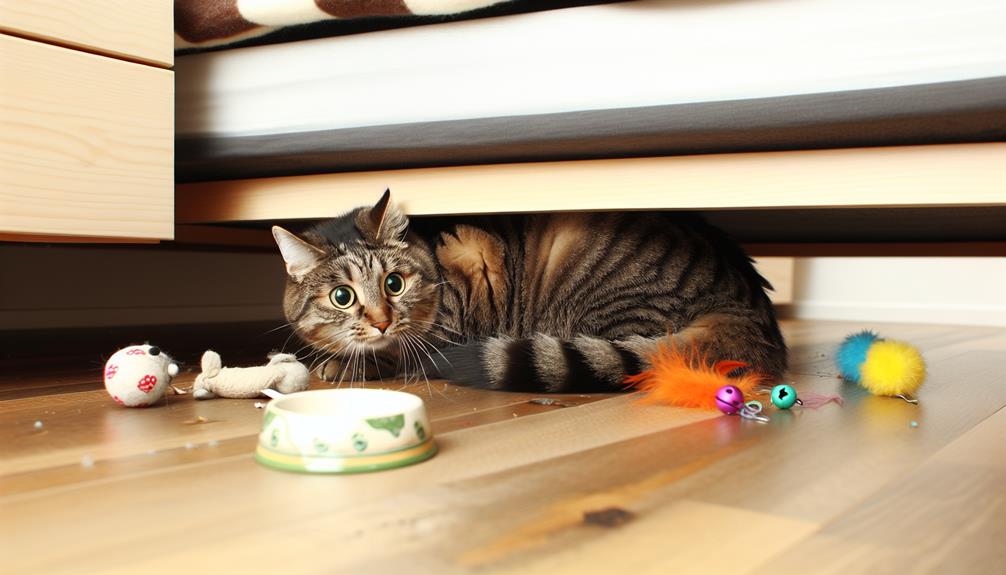
If your feline companion starts exhibiting unusual behavior, it may be a sign that they're experiencing stress. Stress in cats can manifest through various behaviors such as excessive grooming, hiding, aggression, or changes in appetite. To ensure the well-being of your cat, it's crucial to focus on stress management and relief.
Understanding feline behavior patterns is essential for effective stress management. Cats are sensitive animals, and changes in their environment or routine can trigger stress. Providing a consistent and comfortable living space can help reduce their anxiety levels. Additionally, engaging in interactive play sessions and offering stimulating toys can be beneficial for stress relief and overall cat well-being.
Observing your cat's body language and reactions can give you valuable insights into their emotional state. By recognizing the signs of stress early on, you can take proactive steps to address the underlying causes and create a calming environment for your beloved feline friend. Remember, a stress-free cat is a happy cat.
Joy and Playfulness in Cats
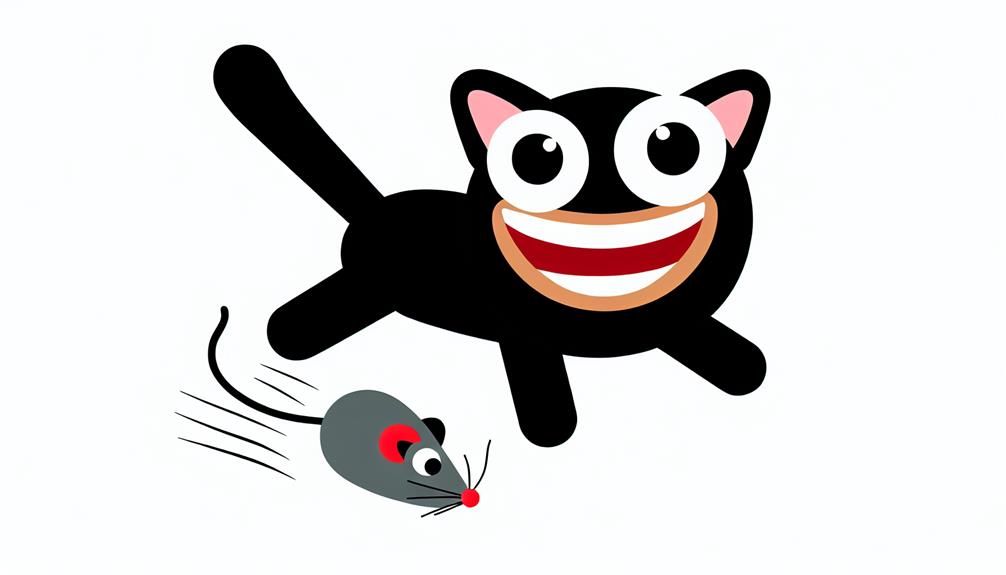
When observing your cat, you'll often notice their joy and playfulness reflected in their energetic movements and curious explorations of their surroundings. Cats exhibit a range of behaviors that indicate their happiness and zest for life.
- Playful antics: Cats engage in various playful behaviors such as chasing toys, pouncing on imaginary prey, and performing acrobatic jumps. These playful antics not only provide physical exercise but also stimulate their minds, keeping them mentally sharp and entertained.
- Joyful interactions: Cats display joy through interactions with their human companions, other pets, or even in solitary moments of contentment. Purring, kneading, and rubbing against you're all signs of their happiness and affection. These interactions not only strengthen the bond between you and your cat but also contribute to their overall well-being.
- Curiosity and exploration: Cats are naturally curious creatures, and their playful nature often leads them to explore their environment with keen interest. From investigating new objects to peeking into hidden corners, their inquisitive behavior reflects their joy in discovering the world around them.
The Complexity of Cat Emotions
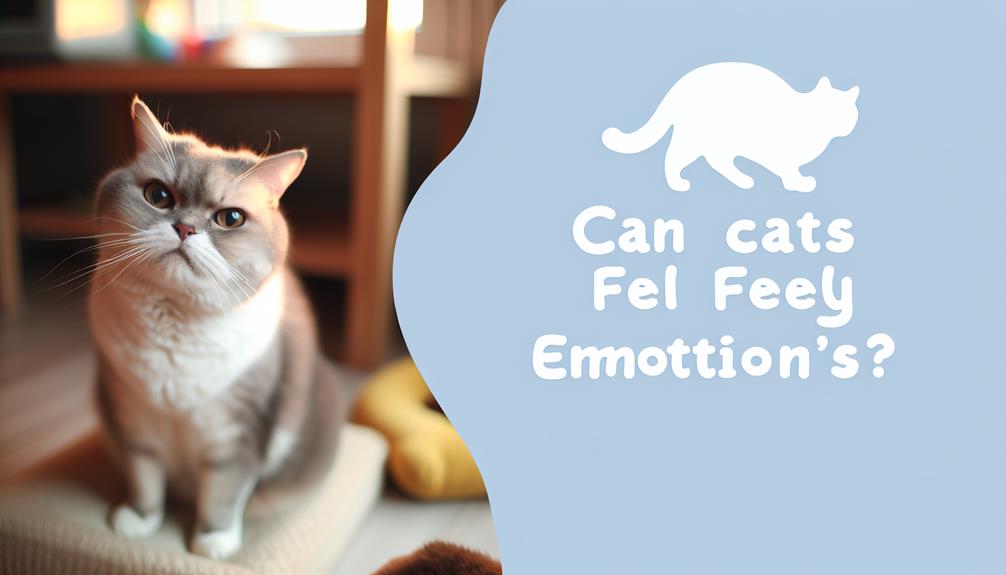
Understanding the intricate emotional world of cats requires keen observation and an appreciation for their subtle cues and behaviors. Cat emotions aren't always straightforward; they possess a rich tapestry of feelings that contribute to their emotional complexity. Cats can experience a wide range of emotions, including joy, fear, affection, and even jealousy. Just like humans, they can also feel stress, anxiety, and sadness.
Emotional complexity in cats can be seen through their body language and vocalizations. A cat's ears, tail, eyes, and overall posture can provide valuable insights into their current emotional state. For example, a cat with flattened ears and a swishing tail may be feeling agitated or angry, while a cat with relaxed ears and slow blinking eyes may be content and relaxed.
Frequently Asked Questions
Can Cats Experience Jealousy Towards Other Pets in the Household?
When it comes to inter-pet rivalry, cats might exhibit feline resentment towards other pets in the household. They can feel territorial and protective of their space, leading to behaviors that show jealousy.
Do Cats Show Emotions Differently Towards Different Family Members?
You'll notice that cats express varied emotions towards different family members. Through body language and vocal cues, they demonstrate attachment and bonding dynamics uniquely. Pay attention to their reactions and interactions with each individual.
How Do Cats Express Their Emotions Towards Inanimate Objects?
When it comes to expressing emotions towards inanimate objects, cats may display playful antics like chasing toys or curious stares at new items. They may also show affectionate cuddles or territorial behavior towards objects they consider their own.
Can Cats Feel Nostalgia or Longing for Past Experiences?
When it comes to nostalgia in cats, they can indeed form emotional attachments to past experiences. This can manifest in behaviors like seeking out familiar scents or places, showing signs of longing for moments gone by.
Do Cats Exhibit Emotions Differently Based on Their Breed or Personality Traits?
Different cat breeds may show emotional traits uniquely, while variations in personality can influence how emotions are displayed. Understanding your cat's breed and individuality helps you recognize and respond to their emotional cues effectively.
Conclusion
In conclusion, cats are definitely capable of feeling a wide range of emotions, from happiness and love to sadness and stress. By paying attention to their body language and behaviors, you can better understand and support your feline friend's emotional well-being.
Building a strong bond based on trust and compassion will help your cat navigate their emotional landscape with comfort and security. So, keep showing them love and care to ensure a happy and healthy relationship.







